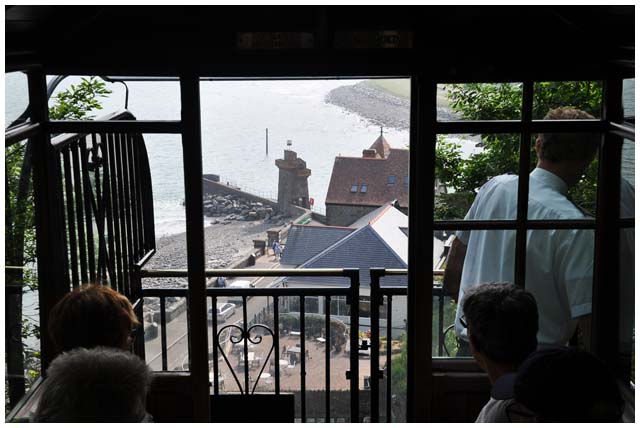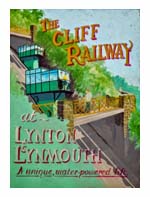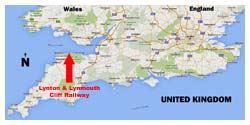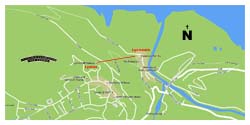
![]() The Lynmouth & Lynton Lift Company
The Lynmouth & Lynton Lift Company
The Esplanade
Lynmouth
North Devon
England
United Kingdom
N51.231172 W3.835419 (Walkway at upper terminus)
 OK... now here's something a little different in the way of railways. A water powered incline railway, but not your average water powered incline railway, this one is unique in that it doesn't use any pumps. It may be one of a few or perhaps the only gravity fed water powered incline railway in the world today. The site is located in Exmoor National Park, North Devon, England, United Kingdom, and connects Lynmouth near sea level with the town of Lynton 500 feet above along two 3 foot 9 inch gauge tracks 862 feet in length.
OK... now here's something a little different in the way of railways. A water powered incline railway, but not your average water powered incline railway, this one is unique in that it doesn't use any pumps. It may be one of a few or perhaps the only gravity fed water powered incline railway in the world today. The site is located in Exmoor National Park, North Devon, England, United Kingdom, and connects Lynmouth near sea level with the town of Lynton 500 feet above along two 3 foot 9 inch gauge tracks 862 feet in length.
Sir George Newnes (1851-1910) was a wealthy magazine publisher, best known for his "Strand Magazine" publishing the Sherlock Holmes mystery series, who took a liking to Lynton and Lynmouth building a large home at Lynton. He was responsible for financing the Lynton & Barnstaple Railway connecting Lynton with standard gauge trains at Barnstaple plus the Lynton and Lynmouth Cliff Railway. Prior to the coming of the incline railway horses were used to transport goods from the port at Lynmouth up the steep hill to Lynton. A horses' working life was cruel and brief on the steep road up to Lynton. The story has it this appalled Sir George who decided to construct the cliff railway. An Act of Parliament formed the Lynmouth & Lynton Lift Company in 1888 with a further Act giving the company perpetual rights to the water from the Lyn Valley. Design and construction was commenced by George Croydon Marks (later Baron Marks of Woolwich) and operation of the incline railway began in 1890. The railway has now been operating for 126 years without a single accident.

The system is comprised of two water tanks, with passenger compartments attached to the top, mounted on wheels running along two parallel tracks laid on a 1 in 1.75 grade (57 percent) on the side of a cliff overlooking Lynmouth townsite. The two tanks, or cars, are connected by continuous steel cables which pass over a large pulley at the top and bottom of the incline. Water from a reservoir kept full by a mile long pipe from the Lyn River is used to fill a car's tank at the top of the incline. That car's tank is drained at the bottom of the incline and flows out into the sea. The entire system is environmentally neutral as the water to supply the system empties into the sea at Lynmouth just as the originating river did. Only a small portion being diverted to fuel the railway.
Let's go through a cycle to help you visualize the operation. For a starting point we'll place one car at the top of the incline and one at the bottom. The bottom car has a full tank of water and the top car is now full after being filled from the reservoir above the top level of the incline. Each car can hold 700 gallons of water. The weight of water is 8.345404 pounds per gallon so that calculates to about 5,842 pounds per car. We have to also add the weight of the car itself, which is unknown at this time, so let's just round the whole thing up to 6,000 pounds per car. (It's more likely greater but this is just for explanation purposes.) So... we have the top car weighing 6,000 pounds and the bottom car weighing 6,000 pounds. Obviously nothing will happen as the two balance each other. Now lets add, say 10 passengers at 200 pounds, to the bottom car bringing that car's weight up to 8,000 pounds. Again, no movement of the cars, as the lighter car at the top can't possibly lift something heavier. So how do we get the top car to be heavier so it will lift the lower car? Easy, the operator of the lower car opens a valve and begins to drain water from the 8,000 pound car. When the weight of the lower car becomes less than the 6,000 pound car at the top of the incline the top car begins to roll down by gravity pulling the lower car up by the attached cable wound around the pulley at the top. Once the cars are moving the lower car operator stops draining water or the cars might accelerate so fast as to become dangerous. When the lighter car reaches the top it is filled with water and the process is repeated, endlessly, with only the cost of maintenance of the equipment and no expenditure of energy.
If you think about the above example the weight of each car is unimportant, except perhaps for the maximum weight which might be applied to the cables. The passenger compartments have a sign stating 40 persons maximum, which, to my mind, would make for very cramped quarters. But no matter how many people board at the top, or bottom of the incline, water is drained from the bottom car until it starts to lift.
But we need brakes, don't we? Of course, and there are two types of brakes on each car plus a safety locking device at the bottom of the incline. The main brake is a caliper type which grips each side of the rail. This brake is operated by the driver through the use of a ship's type steering wheel located on the outer platform of each car. This is a "deadman's brake". Unattended the brake is "on" and clamps the brake calipers to each side of the rail's crown. The wheel is held in this "on" position by a heavy weight. To release the brake the driver must turn the wheel lifting the weight and releasing the grip on the rail. With this brake in the "on" position it is impossible to move the car. Should he inadvertently let go of the wheel the weight will return the brake to the "on" position stopping the cars within 7 or 8 feet.
This main brake is also used to slow a car to a very low speed before it reaches the buffers which then stop the car very smoothly. Once stopped a driver releases the wheel which then clamps the car to the rail ready to fill the water tank once again.
The secondary brake is a shoe type which presses down on the top of the rail. This brake operated by a foot pedal and a governor is used to control the speed of a car as it moves. The governor is driven by the motion of the wheels and applies a braking force when the speed of the car reaches a safe pre-determined speed. Recall the first example here where the lower car begins to rise as water is drained from its tank. Once in motion the governor will control the speed all the way to the top of the incline.
In addition to these devices there is a locking mechanism located at the lower terminal. As a car descends onto the lower buffers an arrow shaped rod engages a locking clamp. So beside being clamped in place by the "deadman's brake" it is also held in position by this lock as water is added to the car at the top of the incline.
You may have noticed the bell mounted over the tracks at the top and bottom of the incline. When passengers have boarded and a driver is ready to move he signals the opposite end with bell signals. The uppermost car releases the "deadman's brake". First, the lower car driver manually releases the locking mechanism. He then winds up the "deadman's brake" to unclamp the car from the rail and presses a foot pedal to begin draining water from the tank. Once the weight of his car is less than the upper car it will be dragged up the incline. As the car's wheels spin the governor it controls the speed of the ascent automatically by the shoe brake acting on the top of the rail.



3 Jun 2010 - A Special Day for a Very Special Man
6 Jan 2013 - Land Slip at Lynton Cliff Railway
18 Sep 2014 - Cliff Railway Wins Engineering Award
17 Apr 2015 - Princess Anne Visits Lynton & Lynmouth Cliff Railway
Lynton & Lynmouth Cliff Railway
FuniMag
Cliff Railways in The South West
Geograph Photos
Visit Lynton and Lynmouth
Sinai House
 Lynton & Lynmouth Cliff RailwayAnonymous AuthorCirca 1970Hamilton-Fisher.Stapled paperback£6.00 (eBay)
Lynton & Lynmouth Cliff RailwayAnonymous AuthorCirca 1970Hamilton-Fisher.Stapled paperback£6.00 (eBay)Postcard-sized stapled booklet with photographs and commentary.
 Lynton & Lynmouth Cliff RailwayAnonymous AuthorDate unknownPublisher unknown.Paperback£2.94 (eBay)
Lynton & Lynmouth Cliff RailwayAnonymous AuthorDate unknownPublisher unknown.Paperback£2.94 (eBay)The booklet is reported by eBay to be in good condition.
 Lynton & Lynmouth Cliff Railway
Lynton & Lynmouth Cliff RailwaySouvenir Guide Limited EditionAnonymous AuthorDate unknownLynton & Lynmouth Cliff Railway.Stapled paperback15 pages, 6 x 8 1/4 inches, £8.99 (eBay)
A description of the incline railway's history, operation, one drawing, with black and white and colour photographs. Available new at the railway ticket office for just £1.00





